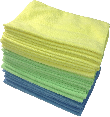Plastic today is as inseparable a part of modern urban life as pollution, because it is such a wonderfully versatile material that one can do anything with. However, in our enthusiasm for all things plastic, we often forget that it requires maintenance if it is to retain its durability and looks. The good news is that a few basic steps can actually keep plastic surfaces and objects in your home stain free, so that removing stains from plastic is no longer a difficult task.
Once a week, clean your plastics with a solution of warm water and mild detergent. The process is simple: just apply the solution on the surface and wipe it off until the soapy feeling disappears. Alternatively, you can use an all-purpose household cleaner. However, take care to use scrubbers that are non-abrasive. Also, use only non-scouring powders; otherwise you can scratch the plastic surface while cleaning. Quite apart from aesthetic considerations, scratches leave the surface prone to staining. One way to protect plastic surfaces from staining is to apply a coat of cleaner wax, which then must be reapplied at regular intervals. In any case, here are some tips on removing stains from plastic. The good news is that you won't have to struggle with common domestic stains like drinks and crayon.
Though I know how to remove many kinds of stains, I can't tell you how to remove hair dye stains from plastic. That is because it can't be done, so do not get hair dye or any other bleach stains on to your plastic laminates. Also, while removing stains from plastic, do not use solvents that are highly inflammable near a heat source. Heat can also warp or melt plastic.

The Power of Microfiber! Zwipes Microfiber Cleaning Cloths will become your favorite tool for every cleaning task. This 36-cloth package is perfect for hundreds of uses in the garage, kitchen, bathroom, laundry, and all around the house. Each cloth is tough, streak-free, lint-free, reusable, and washable. Check out Microfiber Cleaning Cloths today!
Vinyl is a fairly common material to find around the home (and in some cases, on the home). As such it only makes sense ...
Discover MoreIf you have a water source in your home then chances are you face the potential problem of limescale buildup. Cleaning ...
Discover MoreMold and mildew tend to build up between bathroom tiles. To remove these growths, you'll need to scrub first with water, ...
Discover MoreFREE SERVICE: Get tips like this every week in Cleaning Tips from Tips.Net. Enter your address and click "Subscribe."
There are currently no comments for this tip. (Be the first to leave your comment—just use the simple form above!)
FREE SERVICE: Get tips like this every week in Cleaning Tips from Tips.Net. Enter your address and click "Subscribe."
Copyright © 2026 Sharon Parq Associates, Inc.
Comments